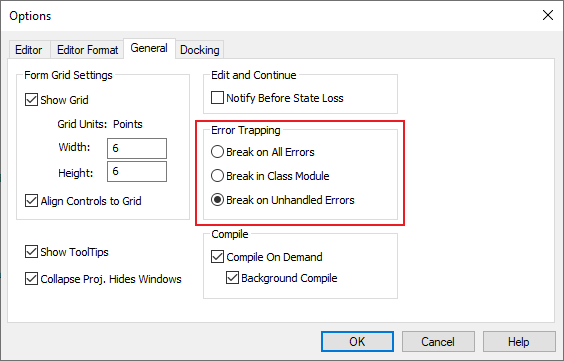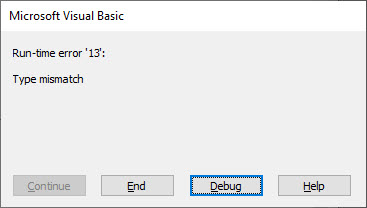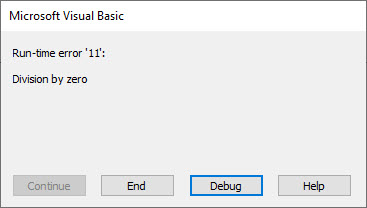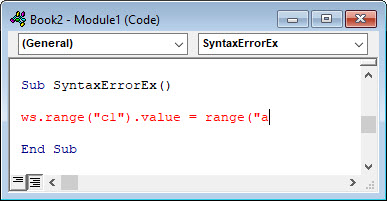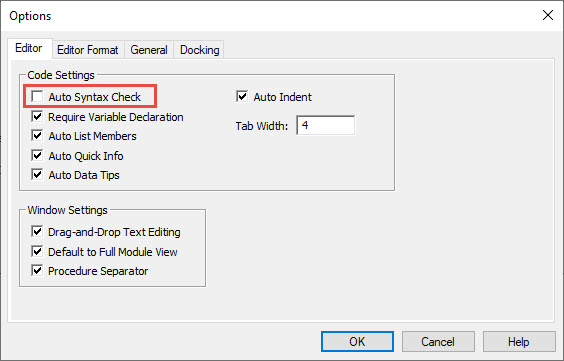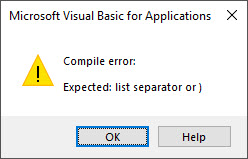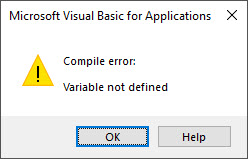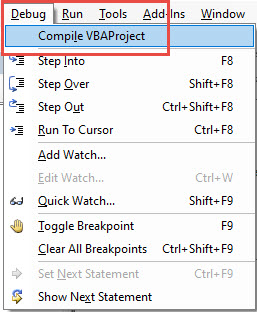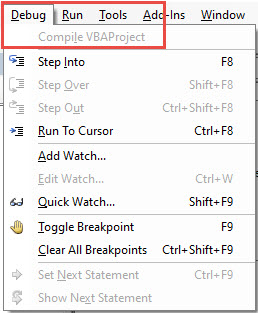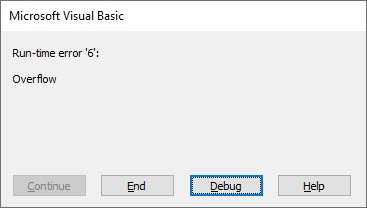Error handling refers to the way runtime errors are handled. Error handling in VBA is done using the On Error statement and the Err object. Runtime errors can be generated by attempting to execute error-causing code or they can be raised explicitly using the Err.Raise method. There are a number of built-in types of runtime errors, and custom errors can be defined as well. Each type of runtime error has a unique number which can be used to determine at runtime which type of error has occurred and respond accordingly.
On Error
The On Error statement is used to control what happens when a runtime error occurs. The On Error statement sets or removes the current error handling scope. When a runtime error occurs in VBA the error trap is triggered and if an On Error statement has been set, VBA will respond according to which type of On Error statement was used.
| Statement | Description |
|---|---|
| On Error Resume Next | Skips lines of code that cause errors. Use with caution. |
| On Error GoTo Line | When an error occurs execution will jump to a specified label or line number. |
| On Error GoTo 0 | Clears the current error and disables error handling. |
| On Error GoTo -1 | Clears the current error and resets the error trap. |
| Resume | When used after the On Error GoTo statement, Resume will continue execution from the line of code that caused the error. |
| Resume Next | When used after the On Error GoTo statement, Resume Next will continue execution from the line of code directly after the line that caused the error. |
| Resume Line | When used after the On Error GoTo statement, Resume Line will jump to a specified label or line number and continue execution. |
On Error Resume Next
Public Sub Example()
On Error Resume Next
Err.Raise 1004
Debug.Print "Error was skipped"
End SubOn Error GoTo Line
Public Sub Example()
On Error GoTo HandleError
Err.Raise 1004
Exit Sub
HandleError:
Debug.Print "Error Handled"
End SubNote: It is not recommended to use line numbers.
Public Sub Example()
10
20 On Error GoTo 80
30
40 Err.Raise 1004
50
60 Exit Sub
70
80 Debug.Print "Error Handled"
90
End SubOn Error GoTo…Resume
Public Sub Example()
Dim N As Long
N = 0
On Error GoTo HandleError
'Divide by zero error will be fixed by error handler
Debug.Print 1 / N
Debug.Print "Error Handled."
Exit Sub
HandleError:
If Err.Number = 11 Then
Debug.Print "Handling 'Division by zero' Error..."
N = 1
Resume
Else
Err.Raise Err.Number
End If
End SubOn Error GoTo…Resume Next
Public Sub Example()
On Error GoTo HandleError
Err.Raise 1004
Debug.Print "Error Handled. Resuming Next..."
Exit Sub
HandleError:
Debug.Print "Handling Error..."
Resume Next
End SubOn Error GoTo…Resume Line
Public Sub Example()
On Error GoTo HandleError
Err.Raise 1004
Continue:
Debug.Print "Resuming..."
Exit Sub
HandleError:
Debug.Print "Error Handled"
Resume Continue
End SubNote: It is not recommended to use line numbers.
Public Sub Example()
10
20 On Error GoTo 100
30
40 Err.Raise 1004
50
60 Debug.Print "Resuming..."
70
80 Exit Sub
90
100 Debug.Print "Error Handled"
110 Resume 60
120
End SubOn Error GoTo 0
Public Sub Example()
On Error Resume Next
Err.Raise 1004 'Error will be skipped
On Error GoTo 0
Err.Raise 1004 'Error will be raised
End SubOn Error GoTo -1
Public Sub Example()
On Error GoTo HandleError1
Err.Raise 1004
Exit Sub
HandleError1:
Debug.Print "HandleError1"
On Error GoTo -1
On Error GoTo HandleError2
Err.Raise 1004
Exit Sub
HandleError2:
Debug.Print "HandleError2"
Exit Sub
End SubThe Err Object
The Err Object is used to access information about a runtime error that has occurred. When a runtime error occurs, the Err object’s properties are filled with information about the error. The Err object can also be used to raise errors explicitly.
| Member | Description |
|---|---|
| Clear | Clears properties of the Err object. Does NOT reset error trap or clear error handling scope. |
| Description | A text description of the error. |
| HelpContext | The context ID for a topic in a help file. |
| HelpFile | The path to help file. |
| LastDllError | Returns a system error code produced by a call to a dynamic-link library (DLL). Read-only. Always returns zero on Mac. |
| Number | The error number, 0 through 65535. |
| Raise | Raises a specified runtime error. |
| Source | The name of the object or application that originated the error. |
The Err Object is a Singleton
The Err object has a single default global instance and cannot be instantiated. The Err object can be accessed anywhere in VBA just by typing Err.
Public Sub Example()
Err.Raise 1004 'No need to instantiate Err object
End SubPublic Sub Example()
Dim E As ErrObject
Set E = New ErrObject 'Causes error
End SubProperties
The Err object’s properties are filled with data when a runtime error occurs. The Number property is especially important because it can be used to dynamically respond to different types of errors. If no runtime error has occurred, the Number property will be 0. Therefore, to determine if an error has occurred in a particular line, the Number property can be checked to see if it is 0 or not.
Public Sub Example()
On Error Resume Next
Err.Raise 1004
If Err.Number <> 0 Then
With Err
Debug.Print "Number: " & .Number
Debug.Print "Description: " & .Description
Debug.Print "Source: " & .Source
Debug.Print "HelpFile: " & .HelpFile
Debug.Print "HelpContext: " & .HelpContext
Debug.Print "LastDllError: " & .LastDllError
End With
Err.Raise Err.Number
Else
Debug.Print "No Error"
End If
End SubClearing The Err Object
The Err object can be reset in a few different ways. The Err object is reset when Err.Clear is called, a Resume or Resume Next statement is executed for the error, or another On Error statement is executed. Exiting an error-causing procedure does not reset the Err object.
Note: Exiting an error-causing procedure does not reset the Err object.
Public Sub Example()
Call ErrorCausingProcedure1
Debug.Print Err.Number 'Prints 1004
Call ErrorCausingProcedure2
Debug.Print Err.Number 'Prints 0
Call ErrorCausingProcedure3
Debug.Print Err.Number 'Prints 0
Call ErrorCausingProcedure4
Debug.Print Err.Number 'Prints 0
End Sub
Public Sub ErrorCausingProcedure1()
'Exiting procedure doe NOT reset the Err object
On Error Resume Next
Err.Raise 1004
End Sub
Public Sub ErrorCausingProcedure2()
'Calling Err.Clear resets the Err object
On Error Resume Next
Err.Raise 1004
Err.Clear
End Sub
Public Sub ErrorCausingProcedure3()
'Resume Next resets the Err object
On Error GoTo HandleError
Err.Raise 1004
Exit Sub
HandleError:
Resume Next
End Sub
Public Sub ErrorCausingProcedure4()
'On Error statement resets the Err object
On Error Resume Next
Err.Raise 1004
On Error GoTo 0
End SubCalling Err.Clear only clears the Err object. Err.Clear does not reset the error handling trap or end the error handling scope. On Error GoTo -1 will clear the Err object and reset error trapping, allowing another error to be raised. On Error GoTo 0 will clear the Err object and clear the error handling scope.
Public Sub Example()
On Error Resume Next
'Error is skipped
Err.Raise 1004
'Prints 1004
Debug.Print Err.Number
'Err object is reset
Err.Clear
'Prints 0
Debug.Print Err.Number
'Error is skipped because error handling scope was not reset
Err.Raise 1004
'Prints 1004
Debug.Print Err.Number
'Clears Err object and error handling scope
On Error GoTo 0
'Prints 0
Debug.Print Err.Number
'Raises a runtime error
Err.Raise 1004
End SubError Trapping Options
Error Trapping options can be selected which can override error handling code in VBA. To change error trapping options navigate to Tools → Options → General in the Visual Basic Editor.
| Option | Description |
|---|---|
| Break on All Errors | Will enter break mode when any error is encountered regardless of error handling code. |
| Break in Class Module | Will enter break mode and show errors inside class modules. |
| Break on Unhandled Errors | This is the default setting. Will enter break mode when an error is encountered and it is not handled by code. |
CVErr Function
The CVErr function can be used to return an error from a function. CVErr returns a value of type Variant with subtype Error. Only variables of type Variant can be assigned a value using the CVErr function. CVErr can take any error number as an argument. CVErr can be used to return a cell error from a user-defined function that is intended for use in spreadsheets.
Option Explicit
Public Function ReturnValueError() As Variant
'Shows #VALUE Error in cell
ReturnValueError = CVErr(xlErrValue)
End Function| xlErr Constant | Cell Error |
|---|---|
| xlErrBlocked | #BLOCKED! |
| xlErrCalc | #CALC! |
| xlErrConnect | #CONNECT! |
| xlErrDiv0 | #DIV/0! |
| xlErrField | #FIELD! |
| xlErrGettingData | #GETTING_DATA |
| xlErrNA | #N/A |
| xlErrName | #NAME? |
| xlErrNull | #NULL! |
| xlErrNum | #NUM! |
| xlErrRef | #REF! |
| xlErrSpill | #SPILL! |
| xlErrUnknown | #UNKNOWN! |
| xlErrValue | #VALUE! |
IsError Function
The IsError function returns True if the argument expression evaluates to an error. IsError can be used to test if a cell value contains an error or a user-defined function returns an error. To return an error from a function use the CVErr function.
Option Explicit
Public Sub Example()
If IsError(Range("A1").Value) Then
Debug.Print "Range A1 contains an error."
End If
Dim E As Variant
E = ReturnError()
If IsError(E) Then
Debug.Print "E is Error: " & CStr(E)
End If
End Sub
Public Function ReturnError() As Variant
ReturnError = CVErr(xlErrValue)
End FunctionError Function
The Error/Error$ function is used to return the description text of an error. The Error function can be used to return a specific error description based on an error number or it can return the description text of the last error to occur.
Specific Error Description
Pass the optional ErrorNumber argument to the Error function to return a specific error description. Although the Error function can take a number between -2147483648 and 65535, it should be intended for use with the range 0 through 65535. If the error number is outside the valid range an Overflow runtime error will occur. If the error number is within the valid range but is not defined, the message «Application-defined or object-defined error» will be returned.
Public Sub Example()
Debug.Print Error(5) 'Prints: Invalid procedure call or argument
End SubMost Recent Error Description
Call the Error function with no ErrorNumber argument to return the description text for the last error to occur. If no error has occurred, a zero-length string will be returned. The Err.Description property can be used to get the text description of the most recent runtime error instead of using the Error function.
Public Sub Example()
On Error Resume Next
Err.Raise 5
Debug.Print Error() 'Prints: Invalid procedure call or argument
End SubRaising Errors
Use the Err.Raise method to raise a runtime error. Errors should be raised when an unacceptable state has been reached in a program. Existing VBA error numbers can be used to raise errors or custom error numbers can be created.
Raising Existing Errors
An appropriate VBA error number can be selected which describes the error.
Public Function RandomLong(MinValue As Long, MaxValue As Long) As Long
If MinValue > MaxValue Then
Err.Raise 5
End If
Randomize
RandomLong = Int((MaxValue - MinValue + 1) * Rnd + MinValue)
End FunctionUser-Defined Errors
To raise a user-defined error, create an error number by using the vbObjectError constant and adding a number between 513 and 65535. The range 0 through 512 is reserved for system errors. The vbObjectError constant has the value -2147221504 so user-defined errors will be negative. To derive the positive portion of a user-defined error simply subtract the vbObjectError constant from the error number.
Public Sub Example()
On Error GoTo HandleError
Err.Raise Number:=vbObjectError + 513, Description:="Custom Error"
Exit Sub
HandleError:
Debug.Print Err.Number - vbObjectError, Err.Description 'Prints: 513 Custom Error
Resume Next
End SubError Statement
The Error statement raises a runtime error for a given error number. The Error statement is included for backward compatibility with older versions of VBA and Err.Raise should be used instead for new code.
Public Sub Example()
'Backward compatible
Error 5
'Use this for new code
Err.Raise 5
End SubError Numbers
Runtime errors each have a number used to identify what type of error it is. Error numbers can be used with the Err.Raise method, the Error statement, and the Error function. When a runtime error occurs, the Err.Number property will be set to the number associated with the type of error. Any positive error number not listed in the table below returns «Application-defined or object-defined error».
| Error Number | Error Text |
|---|---|
| 3 | Return without GoSub |
| 5 | Invalid procedure call or argument |
| 6 | Overflow |
| 7 | Out of memory |
| 9 | Subscript out of range |
| 10 | This array is fixed or temporarily locked |
| 11 | Division by zero |
| 13 | Type mismatch |
| 14 | Out of string space |
| 16 | Expression too complex |
| 17 | Can’t perform requested operation |
| 18 | User interrupt occurred |
| 20 | Resume without error |
| 28 | Out of stack space |
| 35 | Sub or Function not defined |
| 47 | Too many DLL application clients |
| 48 | Error in loading DLL |
| 49 | Bad DLL calling convention |
| 51 | Internal error |
| 52 | Bad file name or number |
| 53 | File not found |
| 54 | Bad file mode |
| 55 | File already open |
| 57 | Device I/O error |
| 58 | File already exists |
| 59 | Bad record length |
| 61 | Disk full |
| 62 | Input past end of file |
| 63 | Bad record number |
| 67 | Too many files |
| 68 | Device unavailable |
| 70 | Permission denied |
| 71 | Disk not ready |
| 74 | Can’t rename with different drive |
| 75 | Path/File access error |
| 76 | Path not found |
| 91 | Object variable or With block variable not set |
| 92 | For loop not initialized |
| 93 | Invalid pattern string |
| 94 | Invalid use of Null |
| 96 | Unable to sink events of object because the object is already firing events to the maximum number of event receivers that it supports |
| 97 | Can not call friend function on object which is not an instance of defining class |
| 98 | A property or method call cannot include a reference to a private object, either as an argument or as a return value |
| 321 (1 — 2) | Invalid file format |
| 322 | Can’t create necessary temporary file |
| 325 | Invalid format in resource file |
| 380 (1 — 2) | Invalid property value |
| 381 | Invalid property array index |
| 382 | Set not supported at runtime |
| 383 | Set not supported (read-only property) |
| 385 | Need property array index |
| 387 | Set not permitted |
| 393 | Get not supported at runtime |
| 394 | Get not supported (write-only property) |
| 422 | Property not found |
| 423 | Property or method not found |
| 424 | Object required |
| 429 | ActiveX component can’t create object |
| 430 | Class does not support Automation or does not support expected interface |
| 432 | File name or class name not found during Automation operation |
| 438 | Object doesn’t support this property or method |
| 440 | Automation error |
| 442 | Connection to type library or object library for remote process has been lost. Press OK for dialog to remove reference. |
| 443 | Automation object does not have a default value |
| 445 | Object doesn’t support this action |
| 446 | Object doesn’t support named arguments |
| 447 | Object doesn’t support current locale setting |
| 448 | Named argument not found |
| 449 | Argument not optional |
| 450 | Wrong number of arguments or invalid property assignment |
| 451 | Property let procedure not defined and property get procedure did not return an object |
| 452 | Invalid ordinal |
| 453 | Specified DLL function not found |
| 454 | Code resource not found |
| 455 | Code resource lock error |
| 457 | This key is already associated with an element of this collection |
| 458 | Variable uses an Automation type not supported in Visual Basic |
| 459 | Object or class does not support the set of events |
| 460 (1 — 2) | Invalid clipboard format |
| 461 | Method or data member not found |
| 462 | The remote server machine does not exist or is unavailable |
| 463 | Class not registered on local machine |
| 481 (1 — 2) | Invalid picture |
| 482 (1 — 2) | Printer error |
| 735 | Can’t save file to TEMP |
| 744 | Search text not found |
| 746 | Replacements too long |
| 1004 | Application-defined or object-defined error |
| 31001 | Application-defined or object-defined error. *Out of memory |
| 31004 | Application-defined or object-defined error. *No object |
| 31018 | Application-defined or object-defined error. *Class is not set |
| 31027 | Application-defined or object-defined error. *Unable to activate object |
| 31032 | Application-defined or object-defined error. *Unable to create embedded object |
| 31036 | Application-defined or object-defined error. *Error saving to file |
| 31037 | Application-defined or object-defined error. *Error loading from file |
| title | keywords | f1_keywords | ms.prod | ms.assetid | ms.date | ms.localizationpriority |
|---|---|---|---|---|---|---|
|
Elements of run-time error handling |
vbaac10.chm5186924 |
vbaac10.chm5186924 |
access |
a0e06a1e-2709-aa51-92d0-340788a31a8a |
09/21/2018 |
medium |
Errors and error handling
When you are programming an application, you need to consider what happens when an error occurs. An error can occur in your application for one of two of reasons. First, some condition at the time the application is running makes otherwise valid code fail. For example, if your code attempts to open a table that the user has deleted, an error occurs. Second, your code may contain improper logic that prevents it from doing what you intended. For example, an error occurs if your code attempts to divide a value by zero.
If you’ve implemented no error handling, then Visual Basic halts execution and displays an error message when an error occurs in your code. The user of your application is likely to be confused and frustrated when this happens. You can forestall many problems by including thorough error-handling routines in your code to handle any error that may occur.
When adding error handling to a procedure, you should consider how the procedure will route execution when an error occurs. The first step in routing execution to an error handler is to enable an error handler by including some form of the On Error statement within the procedure. The On Error statement directs execution in event of an error. If there’s no On Error statement, Visual Basic simply halts execution and displays an error message when an error occurs.
When an error occurs in a procedure with an enabled error handler, Visual Basic doesn’t display the normal error message. Instead it routes execution to an error handler, if one exists. When execution passes to an enabled error handler, that error handler becomes active. Within the active error handler, you can determine the type of error that occurred and address it in the manner that you choose. Access provides three objects that contain information about errors that have occurred, the ADO Error object, the Visual Basic Err object, and the DAO Error object.
Routing execution when an error occurs
An error handler specifies what happens within a procedure when an error occurs. For example, you may want the procedure to end if a certain error occurs, or you may want to correct the condition that caused the error and resume execution. The On Error and Resume statements determine how execution proceeds in the event of an error.
On Error statement
The On Error statement enables or disables an error-handling routine. If an error-handling routine is enabled, execution passes to the error-handling routine when an error occurs.
There are three forms of the On Error statement: On Error GoTo label, On Error GoTo 0, and On Error Resume Next. The On Error GoTo label statement enables an error-handling routine, beginning with the line on which the statement is found. You should enable the error-handling routine before the first line at which an error could occur. When the error handler is active and an error occurs, execution passes to the line specified by the label argument.
The line specified by the label argument should be the beginning of the error-handling routine. For example, the following procedure specifies that if an error occurs, execution passes to the line labeled:
Function MayCauseAnError() ' Enable error handler. On Error GoTo Error_MayCauseAnError . ' Include code here that may generate error. . . Error_MayCauseAnError: . ' Include code here to handle error. . . End Function
The On Error GoTo 0 statement disables error handling within a procedure. It doesn’t specify line 0 as the start of the error-handling code, even if the procedure contains a line numbered 0. If there’s no On Error GoTo 0 statement in your code, the error handler is automatically disabled when the procedure has run completely. The On Error GoTo 0 statement resets the properties of the Err object, having the same effect as the Clear method of the Err object.
The On Error Resume Next statement ignores the line that causes an error and routes execution to the line following the line that caused the error. Execution isn’t interrupted. Use the On Error Resume Next statement if you want to check the properties of the Err object immediately after a line at which you anticipate an error will occur, and handle the error within the procedure rather than in an error handler.
Resume statement
The Resume statement directs execution back to the body of the procedure from within an error-handling routine. You can include a Resume statement within an error-handling routine if you want execution to continue at a particular point in a procedure. However, a Resume statement isn’t necessary; you can also end the procedure after the error-handling routine.
There are three forms of the Resume statement. The Resume or Resume 0 statement returns execution to the line at which the error occurred. The Resume Next statement returns execution to the line immediately following the line at which the error occurred. The Resume label statement returns execution to the line specified by the label argument. The label argument must indicate either a line label or a line number.
You typically use the Resume or Resume 0 statement when the user must make a correction. For example, if you prompt the user for the name of a table to open, and the user enters the name of a table that doesn’t exist, you can prompt the user again and resume execution with the statement that caused the error.
You use the Resume Next statement when your code corrects for the error within an error handler, and you want to continue execution without rerunning the line that caused the error. You use the Resume label statement when you want to continue execution at another point in the procedure, specified by the label argument. For example, you might want to resume execution at an exit routine, as described in the following section.
Exiting a procedure
When you include an error-handling routine in a procedure, you should also include an exit routine, so that the error-handling routine will run only if an error occurs. You can specify an exit routine with a line label in the same way that you specify an error-handling routine.
For example, you can add an exit routine to the example in the previous section. If an error doesn’t occur, the exit routine runs after the body of the procedure. If an error occurs, then execution passes to the exit routine after the code in the error-handling routine has run. The exit routine contains an Exit statement.
Function MayCauseAnError() ' Enable error handler. On Error GoTo Error_MayCauseAnError . ' Include code here that may generate error. . . Exit_MayCauseAnError: Exit Function Error_MayCauseAnError: . ' Include code to handle error. . . ' Resume execution with exit routine to exit function. Resume Exit_MayCauseAnError End Function
Handling errors in nested procedures
When an error occurs in a nested procedure that doesn’t have an enabled error handler, Visual Basic searches backward through the calls list for an enabled error handler in another procedure, rather than simply halting execution. This provides your code with an opportunity to correct the error within another procedure. For example, suppose Procedure A calls Procedure B, and Procedure B calls Procedure C. If an error occurs in Procedure C and there’s no enabled error handler, Visual Basic checks Procedure B, then Procedure A, for an enabled error handler. If one exists, execution passes to that error handler. If not, execution halts and an error message is displayed.
Visual Basic also searches backward through the calls list for an enabled error handler when an error occurs within an active error handler. You can force Visual Basic to search backward through the calls list by raising an error within an active error handler with the Raise method of the Err object. This is useful for handling errors that you don’t anticipate within an error handler. If an unanticipated error occurs, and you regenerate that error within the error handler, then execution passes back up the calls list to find another error handler, which may be set up to handle the error.
For example, suppose Procedure C has an enabled error handler, but the error handler doesn’t correct for the error that has occurred. Once the error handler has checked for all the errors that you’ve anticipated, it can regenerate the original error. Execution then passes back up the calls list to the error handler in Procedure B, if one exists, providing an opportunity for this error handler to correct the error. If no error handler exists in Procedure B, or if it fails to correct for the error and regenerates it again, then execution passes to the error handler in Procedure A, assuming one exists.
To illustrate this concept in another way, suppose that you have a nested procedure that includes error handling for a type mismatch error, an error which you’ve anticipated. At some point, a division-by-zero error, which you haven’t anticipated, occurs within Procedure C. If you’ve included a statement to regenerate the original error, then execution passes back up the calls list to another enabled error handler, if one exists. If you’ve corrected for a division-by-zero error in another procedure in the calls list, then the error will be corrected. If your code doesn’t regenerate the error, then the procedure continues to run without correcting the division-by-zero error. This in turn may cause other errors within the set of nested procedures.
In summary, Visual Basic searches back up the calls list for an enabled error handler if:
-
An error occurs in a procedure that doesn’t include an enabled error handler.
-
An error occurs within an active error handler. If you use the Raise method of the Err object to raise an error, you can force Visual Basic to search backward through the calls list for an enabled error handler.
Getting information about an error
After execution has passed to the error-handling routine, your code must determine which error has occurred and address it. Visual Basic and Access provide several language elements that you can use to get information about a specific error. Each is suited to different types of errors. Since errors can occur in different parts of your application, you need to determine which to use in your code based on what errors you expect.
The language elements available for error handling include:
-
Err object
-
ADO Error object and Errors collection
-
DAO Error object and Errors collection
-
AccessError method
-
Error event
Err object
The Err object is provided by Visual Basic. When a Visual Basic error occurs, information about that error is stored in the Err object. The Err object maintains information about only one error at a time. When a new error occurs, the Err object is updated to include information about that error instead.
To get information about a particular error, you can use the properties and methods of the Err object:
- The Number property is the default property of the Err object; it returns the identifying number of the error that occurred.
- The Err object’s Description property returns the descriptive string associated with a Visual Basic error.
- The Clear method clears the current error information from the Err object.
- The Raise method generates a specific error and populates the properties of the Err object with information about that error.
The following example shows how to use the Err object in a procedure that may cause a type mismatch error:
Function MayCauseAnError() ' Declare constant to represent likely error. Const conTypeMismatch As Integer = 13 On Error GoTo Error_MayCauseAnError . ' Include code here that may generate error. . . Exit_MayCauseAnError: Exit Function Error_MayCauseAnError: ' Check Err object properties. If Err = conTypeMismatch Then . ' Include code to handle error. . . Else ' Regenerate original error. Dim intErrNum As Integer intErrNum = Err Err.Clear Err.Raise intErrNum End If ' Resume execution with exit routine to exit function. Resume Exit_MayCauseAnError End Function
Note that in the preceding example, the Raise method is used to regenerate the original error. If an error other than a type mismatch error occurs, execution will be passed back up the calls list to another enabled error handler, if one exists.
The Err object provides you with all the information you need about Visual Basic errors. However, it doesn’t give you complete information about Access errors or Access database engine errors. Access and Data Access Objects (DAO)) provide additional language elements to assist you with those errors.
Error object and Errors collection
The Error object and Errors collection are provided by ADO and DAO. The Error object represents an ADO or DAO error. A single ADO or DAO operation may cause several errors, especially if you are performing DAO ODBC operations. Each error that occurs during a particular data access operation has an associated Error object. All the Error objects associated with a particular ADO or DAO operation are stored in the Errors collection, the lowest-level error being the first object in the collection and the highest-level error being the last object in the collection.
When a ADO or DAO error occurs, the Visual Basic Err object contains the error number for the first object in the Errors collection. To determine whether additional ADO or DAO errors have occurred, check the Errors collection. The values of the ADO Number or DAO Number properties and the ADO Description or DAO Description properties of the first Error object in the Errors collection should match the values of the Number and Description properties of the Visual Basic Err object.
AccessError method
Use the Raise method of the Err object to generate a Visual Basic error that hasn’t actually occurred and determine the descriptive string associated with that error. However, you can’t use the Raise method to generate a Access error, an ADO error, or a DAO error. To determine the descriptive string associated with an Access error, an ADO error, or a DAO error that hasn’t actually occurred, use the AccessError method.
Error event
Use the Error event to trap errors that occur on an Access form or report. For example, if a user tries to enter text in a field whose data type is Date/Time, the Error event occurs. If you add an Error event procedure to an Employees form, then try to enter a text value in the HireDate field, the Error event procedure runs.
The Error event procedure takes an integer argument, DataErr. When an Error event procedure runs, the DataErr argument contains the number of the Access error that occurred. Checking the value of the DataErr argument within the event procedure is the only way to determine the number of the error that occurred. The Err object isn’t populated with error information after the Error event occurs. Use the value of the DataErr argument together with the AccessError method to determine the number of the error and its descriptive string.
[!NOTE]
The Error statement and Error function are provided for backward compatibility only. When writing new code, use the Err and Error objects, the AccessError function, and the Error event for getting information about an error.
About the contributors
Link provided by 
- Handling Access Errors with VBA
UtterAccess is the premier Microsoft Access wiki and help forum.
See also
- Access for developers forum
- Access help on support.office.com
- Access forums on UtterAccess
- Access developer and VBA programming help center (FMS)
- Access posts on StackOverflow
[!includeSupport and feedback]
Contains a searchable list of common (core) VBA error codes used by the intrinsic Err object, as well as a separate list of all other errors.
When an error is generated in your application—whether it’s handled or not—the properties of the Err object are assigned values with information about the error that just occurred. You can access this information, or generate your own errors explicitly using the Err.Raise method.
Err.Raise Number, [Source], [Description], [HelpFile], [HelpContext]This, of course, requires knowledge of the error codes understood by the Err object. These are listed in searchable tables below (with hyperlinks to associated MSDN pages where available) . Error codes and descriptions were obtained from the following sources:
- Core Visual Basic Language Errors
- Miscellaneous Visual Basic Errors
- ActiveX Control Errors
You can also define your own errors to unify the error-handling process. For example, see the article: Organizing Unstructured Errors in VBA.
Add the vbObjectError constant to custom error codes to guaranteed that the resulting number is not already in use.
Common VBA Error Codes
In this Article
- VBA Errors Cheat Sheet
- Errors
- VBA Error Handling
- VBA On Error Statement
- On Error GoTo 0
- On Error Resume Next
- Err.Number, Err.Clear, and Catching Errors
- On Error GoTo Line
- VBA IsError
- If Error VBA
- VBA Error Types
- Runtime Errors
- Syntax Errors
- Compile Errors
- Debug > Compile
- OverFlow Error
- Other VBA Error Terms
- VBA Catch Error
- VBA Ignore Error
- VBA Throw Error / Err.Raise
- VBA Error Trapping
- VBA Error Message
- VBA Error Handling in a Loop
- VBA Error Handling in Access
VBA Errors Cheat Sheet
Errors
On Error – Stop code and display error
On Error Goto 0
On Error – Skip error and continue running
On Error Resume Next
On Error – Go to a line of code [Label]
On Error Goto [Label]
Clears (Resets) Error
On Error GoTo –1
Show Error number
MsgBox Err.Number
Show Description of error
MsgBox Err.Description
Function to generate own error
Err.Raise
See more VBA “Cheat Sheets” and free PDF Downloads
VBA Error Handling
VBA Error Handling refers to the process of anticipating, detecting, and resolving VBA Runtime Errors. The VBA Error Handling process occurs when writing code, before any errors actually occur.
VBA Runtime Errors are errors that occur during code execution. Examples of runtime errors include:
- Referencing a non-existent workbook, worksheet, or other object (Run-time Error 1004)
- Invalid data ex. referencing an Excel cell containing an error (Type Mismatch – Run-time Error 13)
- Attempting to divide by zero
VBA On Error Statement
Most VBA error handling is done with the On Error Statement. The On Error statement tells VBA what to do if it encounters an error. There are three On Error Statements:
- On Error GoTo 0
- On Error Resume Next
- On Error GoTo Line
On Error GoTo 0
On Error GoTo 0 is VBA’s default setting. You can restore this default setting by adding the following line of code:
On Error GoTo 0When an error occurs with On Error GoTo 0, VBA will stop executing code and display its standard error message box.
Often you will add an On Error GoTo 0 after adding On Error Resume Next error handling (next section):
Sub ErrorGoTo0()
On Error Resume Next
ActiveSheet.Shapes("Start_Button").Delete
On Error GoTo 0
'Run More Code
End SubOn Error Resume Next
On Error Resume Next tells VBA to skip any lines of code containing errors and proceed to the next line.
On Error Resume NextNote: On Error Resume Next does not fix an error, or otherwise resolve it. It simply tells VBA to proceed as if the line of code containing the error did not exist. Improper use of On Error Resume Next can result in unintended consequences.
A great time to use On Error Resume Next is when working with objects that may or may not exist. For example, you want to write some code that will delete a shape, but if you run the code when the shape is already deleted, VBA will throw an error. Instead you can use On Error Resume Next to tell VBA to delete the shape if it exists.
On Error Resume Next
ActiveSheet.Shapes("Start_Button").Delete
On Error GoTo 0Notice we added On Error GoTo 0 after the line of code containing the potential error. This resets the error handling.
In the next section we’ll show you how to test if an error occurred using Err.Number, giving you more advanced error handling options.
VBA Coding Made Easy
Stop searching for VBA code online. Learn more about AutoMacro — A VBA Code Builder that allows beginners to code procedures from scratch with minimal coding knowledge and with many time-saving features for all users!
Learn More
Err.Number, Err.Clear, and Catching Errors
Instead of simply skipping over a line containing an error, we can catch the error by using On Error Resume Next and Err.Number.
Err.Number returns an error number corresponding with the type of error detected. If there is no error, Err.Number = 0.
For example, this procedure will return “11” because the error that occurs is Run-time error ’11’.
Sub ErrorNumber_ex()
On Error Resume Next
ActiveCell.Value = 2 / 0
MsgBox Err.Number
End SubError Handling with Err.Number
The true power of Err.Number lies in the ability to detect if an error occurred (Err.Number <> 0). In the example below, we’ve created a function that will test if a sheet exists by using Err.Number.
Sub TestWS()
MsgBox DoesWSExist("test")
End Sub
Function DoesWSExist(wsName As String) As Boolean
Dim ws As Worksheet
On Error Resume Next
Set ws = Sheets(wsName)
'If Error WS Does not exist
If Err.Number <> 0 Then
DoesWSExist = False
Else
DoesWSExist = True
End If
On Error GoTo -1
End FunctionNote: We’ve added a On Error GoTo -1 to the end which resets Err.Number to 0 (see two sections down).
With On Error Resume Next and Err.Number, you can replicate the “Try” & “Catch” functionality of other programming languages.
On Error GoTo Line
On Error GoTo Line tells VBA to “go to” a labeled line of code when an error is encountered. You declare the Go To statement like this (where errHandler is the line label to go to):
On Error GoTo errHandlerand create a line label like this:
errHandler:Note: This is the same label that you’d use with a regular VBA GoTo Statement.
Below we will demonstrate using On Error GoTo Line to Exit a procedure.
On Error Exit Sub
You can use On Error GoTo Line to exit a sub when an error occurs.
You can do this by placing the error handler line label at the end of your procedure:
Sub ErrGoToEnd()
On Error GoTo endProc
'Some Code
endProc:
End Subor by using the Exit Sub command:
Sub ErrGoToEnd()
On Error GoTo endProc
'Some Code
GoTo skipExit
endProc:
Exit Sub
skipExit:
'Some More Code
End SubErr.Clear, On Error GoTo -1, and Resetting Err.Number
After an error is handled, you should generally clear the error to prevent future issues with error handling.
After an error occurs, both Err.Clear and On Error GoTo -1 can be used to reset Err.Number to 0. But there is one very important difference: Err.Clear does not reset the actual error itself, it only resets the Err.Number.
What does that mean? Using Err.Clear, you will not be able to change the error handling setting. To see the difference, test out this code and replace On Error GoTo -1 with Err.Clear:
Sub ErrExamples()
On Error GoTo errHandler:
'"Application-defined" error
Error (13)
Exit Sub
errHandler:
' Clear Error
On Error GoTo -1
On Error GoTo errHandler2:
'"Type mismatch" error
Error (1034)
Exit Sub
errHandler2:
Debug.Print Err.Description
End SubTypically, I recommend always using On Error GoTo -1, unless you have a good reason to use Err.Clear instead.
VBA On Error MsgBox
You might also want to display a Message Box on error. This example will display different message boxes depending on where the error occurs:
Sub ErrorMessageEx()
Dim errMsg As String
On Error GoTo errHandler
'Stage 1
errMsg = "An error occured during the Copy & Paste stage."
'Err.Raise (11)
'Stage 2
errMsg = "An error occured during the Data Validation stage."
'Err.Raise (11)
'Stage 3
errMsg = "An error occured during the P&L-Building and Copy-Over stage."
Err.Raise (11)
'Stage 4
errMsg = "An error occured while attempting to log the Import on the Setup Page"
'Err.Raise (11)
GoTo endProc
errHandler:
MsgBox errMsg
endProc:
End SubHere you would replace Err.Raise(11) with your actual code.
VBA IsError
Another way to handle errors is to test for them with the VBA ISERROR Function. The ISERROR Function tests an expression for errors, returning TRUE or FALSE if an error occurs.
Sub IsErrorEx()
MsgBox IsError(Range("a7").Value)
End SubVBA Programming | Code Generator does work for you!
If Error VBA
You can also handle errors in VBA with the Excel IFERROR Function. The IFERROR Function must be accessed by using the WorksheetFunction Class:
Sub IfErrorEx()
Dim n As Long
n = WorksheetFunction.IfError(Range("a10").Value, 0)
MsgBox n
End SubThis will output the value of Range A10, if the value is an error, it will output 0 instead.
VBA Error Types
Runtime Errors
As stated above:
VBA Runtime Errors are errors that occur during code execution. Examples of runtime errors include:
- Referencing a non-existent workbook, worksheet, or other object
- Invalid data ex. referencing an Excel cell containing an error
- Attempting to divide by zero
You can “error handle” runtime errors using the methods discussed above.
Syntax Errors
VBA Syntax Errors are errors with code writing. Examples of syntax errors include:
- Mispelling
- Missing or incorrect punctuation
The VBA Editor identifies many syntax errors with red highlighting:
The VBA Editor also has an option to “Auto Syntax Check”:
When this is checked, the VBA Editor will generate a message box alerting you syntax errors after you enter a line of code:
I personally find this extremely annoying and disable the feature.
Compile Errors
Before attempting to run a procedure, VBA will “compile” the procedure. Compiling transforms the program from source code (that you can see) into executable form (you can’t see).
VBA Compile Errors are errors that prevent the code from compiling.
A good example of a compile error is a missing variable declaration:
Other examples include:
- For without Next
- Select without End Select
- If without End If
- Calling a procedure that does not exist
Syntax Errors (previous section) are a subset of Compile Errors.
AutoMacro | Ultimate VBA Add-in | Click for Free Trial!
Debug > Compile
Compile errors will appear when you attempt to run a Procedure. But ideally, you would identify compile errors prior to attempting to run the procedure.
You can do this by compiling the project ahead of time. To do so, go to Debug > Compile VBA Project.
The compiler will “go to” the first error. Once you fix that error, compile the project again. Repeat until all errors are fixed.
You can tell that all errors are fixed because Compile VBA Project will be grayed out:
OverFlow Error
The VBA OverFlow Error occurs when you attempt to put a value into a variable that is too large. For example, Integer Variables can only contain values between -32,768 to 32,768. If you enter a larger value, you’ll receive an Overflow error:
Instead, you should use the Long Variable to store the larger number.
Other VBA Error Terms
VBA Catch Error
Unlike other programming languages, In VBA there is no Catch Statement. However, you can replicate a Catch Statement by using On Error Resume Next and If Err.Number <> 0 Then. This is covered above in Error Handling with Err.Number.
AutoMacro | Ultimate VBA Add-in | Click for Free Trial!
VBA Ignore Error
To ignore errors in VBA, simply use the On Error Resume Next statement:
On Error Resume NextHowever, as mentioned above, you should be careful using this statement as it doesn’t fix an error, it just simply ignores the line of code containing the error.
VBA Throw Error / Err.Raise
To through an error in VBA, you use the Err.Raise method.
This line of code will raise Run-time error ’13’: Type mismatch:
Err.Raise (13)VBA Error Trapping
VBA Error Trapping is just another term for VBA Error Handling.
VBA Error Message
A VBA Error Message looks like this:
When you click ‘Debug’, you’ll see the line of code that is throwing the error:
AutoMacro | Ultimate VBA Add-in | Click for Free Trial!
VBA Error Handling in a Loop
The best way to error handle within a Loop is by using On Error Resume Next along with Err.Number to detect if an error has occurred (Remember to use Err.Clear to clear the error after each occurrence).
The example below will divide two numbers (Column A by Column B) and output the result into Column C. If there’s an error, the result will be 0.
Sub test()
Dim cell As Range
On Error Resume Next
For Each cell In Range("a1:a10")
'Set Cell Value
cell.Offset(0, 2).Value = cell.Value / cell.Offset(0, 1).Value
'If Cell.Value is Error then Default to 0
If Err.Number <> 0 Then
cell.Offset(0, 2).Value = 0
Err.Clear
End If
Next
End SubVBA Error Handling in Access
All of the above examples work exactly the same in Access VBA as in Excel VBA.
Function DelRecord(frm As Form)
'this function is used to delete a record in a table from a form
On Error GoTo ending
With frm
If .NewRecord Then
.Undo
Exit Function
End If
End With
With frm.RecordsetClone
.Bookmark = frm.Bookmark
.Delete
frm.Requery
End With
Exit Function
ending:
End
End Function
Избегание условий ошибки
Когда возникает ошибка времени выполнения, хороший код должен ее обрабатывать. Лучшей стратегией обработки ошибок является запись кода, который проверяет условия ошибки и просто избегает выполнения кода, который приводит к ошибке выполнения.
Одним из ключевых элементов сокращения ошибок во время выполнения является запись небольших процедур, которые делают одно . Чем меньше процедур процедур приходится терпеть неудачу, тем проще код в целом — отлаживать.
Избежать ошибки времени выполнения 91 — Объект или С заблокированной переменной блока:
Эта ошибка будет повышена, если объект используется до назначения ссылки. Возможно, у вас есть процедура, которая получает параметр объекта:
Private Sub DoSomething(ByVal target As Worksheet)
Debug.Print target.Name
End Sub
Если target не назначена ссылка, приведенный выше код вызовет ошибку, которую легко избежать, проверяя, содержит ли объект фактическую ссылку на объект:
Private Sub DoSomething(ByVal target As Worksheet)
If target Is Nothing Then Exit Sub
Debug.Print target.Name
End Sub
Если target назначению не присвоена ссылка, то непризнанная ссылка никогда не используется, и ошибка не возникает.
Этот способ раннего выхода из процедуры, когда один или несколько параметров недопустимы, называется предложением охраны .
Избегайте ошибки времени выполнения 9 — Подкласс вне диапазона:
Эта ошибка возникает при доступе к массиву за пределами его границ.
Private Sub DoSomething(ByVal index As Integer)
Debug.Print ActiveWorkbook.Worksheets(index)
End Sub
Учитывая, что индекс больше, чем количество листов в ActiveWorkbook , приведенный выше код вызовет ошибку времени выполнения. Простое предложение охраны может избежать этого:
Private Sub DoSomething(ByVal index As Integer)
If index > ActiveWorkbook.Worksheets.Count Or index <= 0 Then Exit Sub
Debug.Print ActiveWorkbook.Worksheets(index)
End Sub
Большинство ошибок времени выполнения можно избежать, тщательно проверив значения, которые мы используем, прежде чем мы их используем, и разветвляемся на другом пути выполнения, соответственно, используя простой оператор If — в сторожевых предложениях, который не делает предположений и не проверяет параметры процедуры, или даже в тело более крупных процедур.
Оператор Error
Даже с защитными пунктами, один не может реально всегда учитывать все возможные ошибки , которые могут быть подняты в теле процедуры. Оператор On Error GoTo инструктирует VBA перейти к метке линии и ввести «режим обработки ошибок» всякий раз, когда во время выполнения происходит непредвиденная ошибка. После обработки ошибки, код может возобновить обратно в «нормальное» исполнение с помощью Resume ключевое слово.
Линейные метки обозначают подпрограммы : потому что подпрограммы исходят из устаревшего кода BASIC и используют GoSub GoTo и GoSub и Return чтобы вернуться к «основной» процедуре, довольно легко написать жесткий код спагетти, если все не строго структурировано , По этой причине лучше всего:
- процедура имеет одну и только одну подпрограмму обработки ошибок
- подпрограмма обработки ошибок работает только в состоянии ошибки
Это означает, что процедура, которая обрабатывает его ошибки, должна быть структурирована следующим образом:
Private Sub DoSomething()
On Error GoTo CleanFail
'procedure code here
CleanExit:
'cleanup code here
Exit Sub
CleanFail:
'error-handling code here
Resume CleanExit
End Sub
Стратегии обработки ошибок
Иногда вы хотите обрабатывать разные ошибки с помощью разных действий. В этом случае вы будете проверять глобальный объект Err , который будет содержать информацию об ошибке, которая была поднята, и действовать соответственно:
CleanExit:
Exit Sub
CleanFail:
Select Case Err.Number
Case 9
MsgBox "Specified number doesn't exist. Please try again.", vbExclamation
Resume
Case 91
'woah there, this shouldn't be happening.
Stop 'execution will break here
Resume 'hit F8 to jump to the line that raised the error
Case Else
MsgBox "An unexpected error has occurred:" & vbNewLine & Err.Description, vbCritical
Resume CleanExit
End Select
End Sub
В качестве общего руководства рассмотрите возможность включения обработки ошибок для всей подпрограммы или функции и обработайте все ошибки, которые могут возникнуть в пределах ее области действия. Если вам нужно обрабатывать ошибки только в секции небольшого сечения кода — включить и выключить обработку ошибок на одном уровне:
Private Sub DoSomething(CheckValue as Long)
If CheckValue = 0 Then
On Error GoTo ErrorHandler ' turn error handling on
' code that may result in error
On Error GoTo 0 ' turn error handling off - same level
End If
CleanExit:
Exit Sub
ErrorHandler:
' error handling code here
' do not turn off error handling here
Resume
End Sub
Номера строк
VBA поддерживает номера строк в стиле legacy (например, QBASIC). Скрытое свойство Erl можно использовать для идентификации номера строки, которая вызвала последнюю ошибку. Если вы не используете номера строк, Erl только вернет 0.
Sub DoSomething()
10 On Error GoTo 50
20 Debug.Print 42 / 0
30 Exit Sub
40
50 Debug.Print "Error raised on line " & Erl ' returns 20
End Sub
Если вы используете номера строк, но не последовательно, а затем Erl возвращает номер последней строки перед командой, вызвавшей ошибку.
Sub DoSomething()
10 On Error GoTo 50
Debug.Print 42 / 0
30 Exit Sub
50 Debug.Print "Error raised on line " & Erl 'returns 10
End Sub
Имейте в виду, что Erl также имеет только Integer точность и будет бесшумно переполняться. Это означает, что номера строк за пределами целочисленного диапазона дадут неверные результаты:
Sub DoSomething()
99997 On Error GoTo 99999
99998 Debug.Print 42 / 0
99999
Debug.Print Erl 'Prints 34462
End Sub
Номер строки не так актуален, как утверждение, вызвавшее ошибку, и строки нумерации быстро становятся утомительными и не совсем удобны в обслуживании.
Резюме ключевого слова
Подпрограмма обработки ошибок будет либо:
- выполняются до конца процедуры, и в этом случае выполнение возобновляется в процедуре вызова.
- или используйте ключевое слово
Resumeдля возобновления выполнения внутри той же процедуры.
Ключевое слово Resume должно использоваться только в подпрограмме обработки ошибок, потому что если VBA встречает Resume не находясь в состоянии ошибки, возникает ошибка времени выполнения 20 «Возобновить без ошибок».
Существует несколько способов, по которым подпрограмма обработки ошибок может использовать ключевое слово Resume :
-
Resumeиспользуется отдельно, выполнение продолжается в инструкции, вызвавшей ошибку . Если ошибка на самом деле не обрабатывается , прежде чем делать это, то та же ошибка будет поднят снова, и выполнение может войти в бесконечный цикл. -
Resume Nextпродолжает выполнение инструкции сразу после инструкции, вызвавшей ошибку. Если ошибка на самом деле не обрабатывается , прежде чем делать это, то выполнение разрешается продолжать с потенциально недействительными данными, которые могут привести к логическим ошибкам и неожиданному поведению. -
Resume [line label]продолжает выполнение на указанной метке строки (или номер строки, если вы используете номера строк в стиле устаревшего стиля). Обычно это позволяет выполнить некоторый код очистки до того, как будет чисто выйти из процедуры, например, чтобы закрыть соединение с базой данных, прежде чем вернуться к вызывающему.
Вкл.
Сам оператор On Error может использовать ключевое слово Resume чтобы проинструктировать среду выполнения VBA для эффективного игнорирования всех ошибок .
Если ошибка не выполняется до этого, то выполнение разрешено продолжать с потенциально недействительными данными, что может привести к логическим ошибкам и неожиданному поведению .
Вышеупомянутый акцент не может быть особо подчеркнут. On Error Resume Next эффективно игнорирует все ошибки и выталкивает их под ковер . Программа, которая взрывается с ошибкой во время выполнения с учетом недопустимого ввода, — это более эффективная программа, чем программа, которая работает с неизвестными / непреднамеренными данными — будь то только потому, что ошибка намного легче идентифицируется. On Error Resume Next можно легко скрыть ошибки .
Оператор On Error является областью действия процедур — поэтому в данной процедуре обычно должен быть только один , такой оператор On Error .
Однако иногда не удается избежать ошибки, и переключение на подпрограмму обработки ошибок только на Resume Next просто не кажется правильным. В этом конкретном случае утверждение с известным до невозможности может быть обернуто между двумя On Error :
On Error Resume Next
[possibly-failing statement]
Err.Clear 'resets current error
On Error GoTo 0
Команда On Error GoTo 0 сбрасывает обработку ошибок в текущей процедуре, так что любая дополнительная инструкция, вызывающая ошибку времени выполнения , будет необработанной внутри этой процедуры и вместо этого будет переходить в стек вызовов до тех пор, пока она не будет захвачена активным обработчиком ошибок. Если в стеке вызовов нет активного обработчика ошибок, он будет рассматриваться как необработанное исключение.
Public Sub Caller()
On Error GoTo Handler
Callee
Exit Sub
Handler:
Debug.Print "Error " & Err.Number & " in Caller."
End Sub
Public Sub Callee()
On Error GoTo Handler
Err.Raise 1 'This will be handled by the Callee handler.
On Error GoTo 0 'After this statement, errors are passed up the stack.
Err.Raise 2 'This will be handled by the Caller handler.
Exit Sub
Handler:
Debug.Print "Error " & Err.Number & " in Callee."
Resume Next
End Sub
Пользовательские ошибки
Часто при написании специализированного класса вы хотите, чтобы он поднимал свои собственные конкретные ошибки, и вам понадобится чистый способ для кода пользователя / вызова для обработки этих пользовательских ошибок. Оптимальным способом достижения этого является определение специального типа Enum :
Option Explicit
Public Enum FoobarError
Err_FooWasNotBarred = vbObjectError + 1024
Err_BarNotInitialized
Err_SomethingElseHappened
End Enum
Используя встроенную константу vbObjectError пользовательские коды ошибок не перекрываются с зарезервированными / существующими кодами ошибок. Необходимо явно указать только первое значение перечисления, поскольку базовое значение каждого члена Enum 1 больше, чем предыдущий элемент, поэтому базовое значение Err_BarNotInitialized неявно является vbObjectError + 1025 .
Повышение собственных ошибок времени выполнения
Ошибка выполнения может быть повышена с Err.Raise оператора Err.Raise , поэтому пользовательская ошибка Err_FooWasNotBarred может быть повышена следующим образом:
Err.Raise Err_FooWasNotBarred
Метод Err.Raise также может принимать пользовательские параметры Description и Source — по этой причине рекомендуется также определять константы для хранения каждого пользовательского описания ошибки:
Private Const Msg_FooWasNotBarred As String = "The foo was not barred."
Private Const Msg_BarNotInitialized As String = "The bar was not initialized."
А затем создайте выделенный частный метод для повышения каждой ошибки:
Private Sub OnFooWasNotBarredError(ByVal source As String)
Err.Raise Err_FooWasNotBarred, source, Msg_FooWasNotBarred
End Sub
Private Sub OnBarNotInitializedError(ByVal source As String)
Err.Raise Err_BarNotInitialized, source, Msg_BarNotInitialized
End Sub
После этого реализация класса может просто вызвать эти специализированные процедуры для повышения ошибки:
Public Sub DoSomething()
'raises the custom 'BarNotInitialized' error with "DoSomething" as the source:
If Me.Bar Is Nothing Then OnBarNotInitializedError "DoSomething"
'...
End Sub
Клиентский код может обрабатывать Err_BarNotInitialized как и любую другую ошибку, внутри своей собственной подпрограммы обработки ошибок.
Примечание: наследие Error ключевое слово также может быть использован вместо Err.Raise , но это устаревшее / осуждается.

